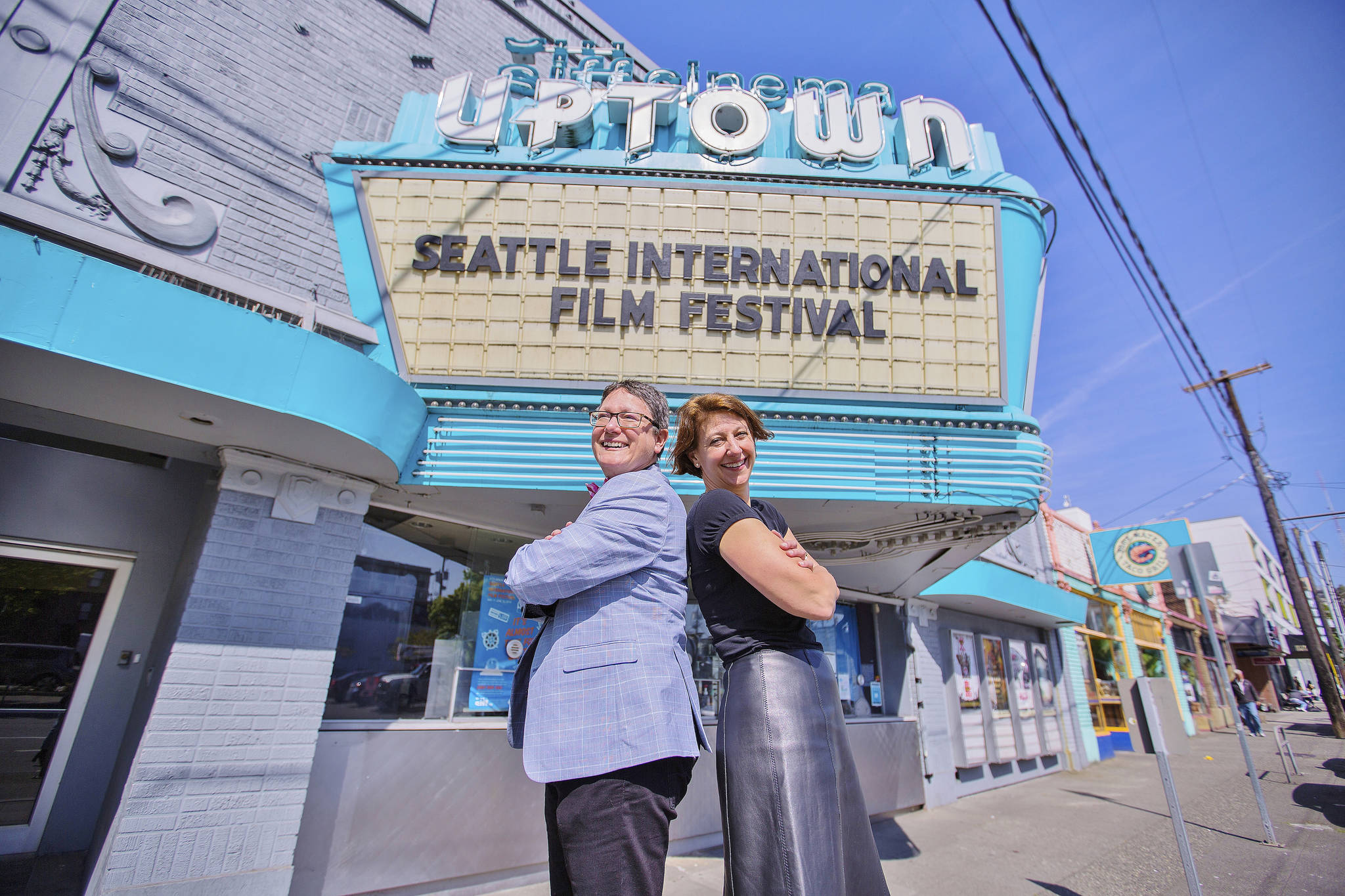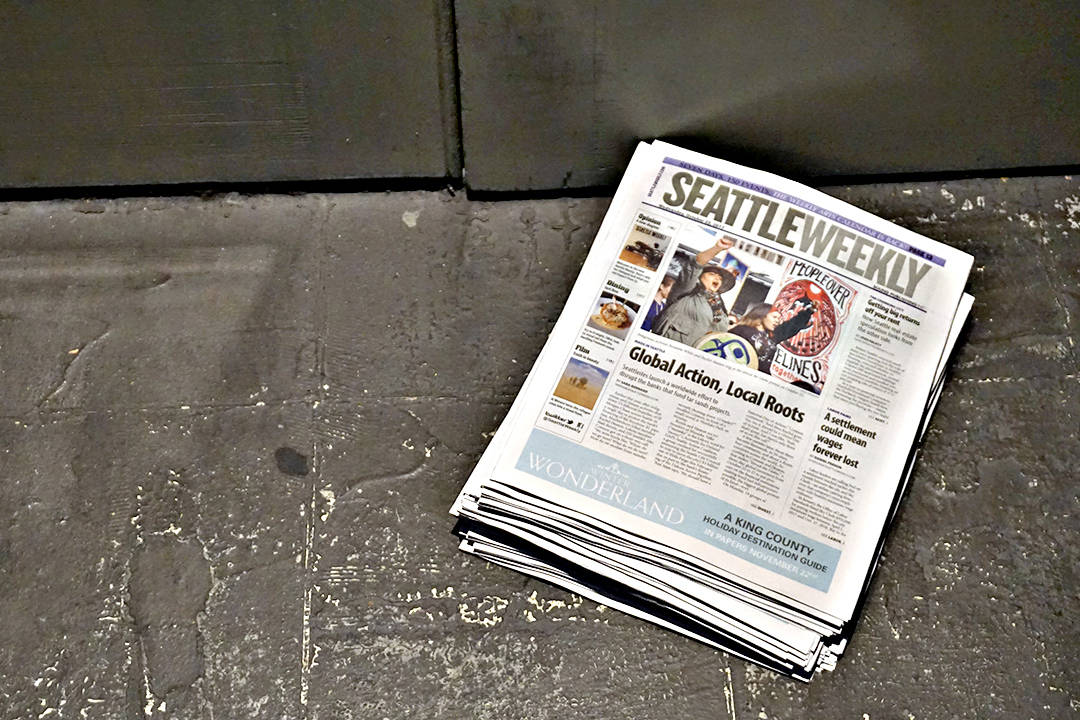When Bruce Pavitt moved from Forest Park, Illinois, to Olympia in 1979, punk rock was nothing new. The scene in the U.K.—frightening to mainstream America—had fizzled and New York was already well into its second wave. And, yet, there was something new to discover in punk: regionalism.
As Pavitt wrote in the first issue of a little zine that he published in May of the next year—500 copies of which he Xeroxed, stapled, and emblazoned with the name Subterranean Pop—fans and creators of underground music need not look to the established cultural capitols for their cues.
”Only by supporting new ideas by local artists, bands, and record labels can the U.S. expect any kind of dynamic social/cultural change in the 1980s,” Pavitt wrote. “This is because the mass homogenization of our culure is due to the claustrophobic centralization of our culture. We need diverse, regionalized, localized approaches to all forms of art, music, and politics.”
And so began one of the most transformative enterprises that the Pacific Northwest, perhaps the nation, and maybe even the world has ever seen. Pavitt’s zine blossomed into a micro-media empire. With the help of fellow punk devotee Calvin Johnson, he published 8 more zines, each bearing a truncated moniker, Sub Pop, and offering up more ambitious ideas, reviews of bands from forgotten cities, and early artwork by Lynda Barry, Charles Burns, and Jad Fair. Then Pavitt moved to Seattle where he spent the next four years reporting on the nation’s growing regional underground in a monthly Sub Pop column for The Rocket. It wasn’t long until he partnered with a man named Jonathan Poneman and began putting out records using that same Sub Pop name, a name that, by then, had become synonymous with Pavitt’s discerning, enthusiastic approach to the underground.
As we all know, Sub Pop signed a band called Nirvana, a band that eventually moved on to a major label and released Nevermind, an album that exploded popular music, introducing the underground to the mainstream and truly putting Pavitt’s ideas about regionalism to the test.
It’s a riveting story, of which most of us only know the second half. Until now.
Following on the publication of his first book, a visual memoir of Nirvana’s first European tour titled Experiencing Nirvana, Pavitt has just published Sub Pop USA: The Subterranean Music Anthology, 1980–1988, which starts with that first zine and ends in 1988, right before grunge became a thing. The thing.
All of the zines and columns are here, alongside insightful, lucid essays from fellow travellers including Johnson, Charles R. Cross, and Larry Reid. The collection is an amazing, spellbinding artifact, filled with radical ideas that deserve a resurgence.
Pavitt is no longer the man behind the Sub Pop name, having left the label in the mid-’90s. He spends his time doing other things now, including having coffee at espresso shops on Orcas Island, which is where he took a call from me late last week. Huddled under a canopy outside, he answered my questions as the November rain of the Pacific Northwest fell around him.
I really love this book, Bruce. I got it in the mail on Monday and was reading it on the bus ride home. I was so into it, I missed my stop by a half mile.It really is a you-are-there document. I was in that rare position where I was both an observer and a participant. And that’s kind of unusual.
When did you decide that you wanted to put this anthology together?The catalyst was really being approached by Bazillion Points to release a hardcover version of Experiencing Nirvana. Ian Christie from Bazillion Points contacted me and in our conversation this project came up. I can’t remember if it was his idea or mine. It just came up in conversation, so it was part of the Experiencing Nirvana book deal. More of an afterthought, but the more I sat with it, the more I thought, Hey, I can get some friends to contribute, get some Charles Peterson photos, and this and that. I love the way it fleshed itself out there.
Do you have a box in your attic that has all of the old Sub Pop zines, or did you have to go hunting for some of this material?Actually, I am somewhat of an archivist. I had all the zines. I had Xeroxed copies of all the columns, but thankfully EMP had originals of all The Rockets. Thankfully they had a young intern sit there and scan every one of those columns, so I was able to have higher quality reproductions on that. So props to the EMP for their archival assistance.
That poor intern.Let me buy that intern a latte.
I love the ads that show up next to the columns. “10 Cents. Sony Super Walkman at Broadway Record Center.”We were kind of debating keeping the ads in and we reached this compromise of having ads on some of the columns, and popping in extra commentary and so forth on others. Some of the ads are so painfully cheesy that it’s hard to look at them. But it really does bring you back to the ‘80s, that’s for sure.
How long had it been since you went back and read all this material?It was a long time. Occasionally I would flip through the zines, but I hadn’t really read everything until the past six months when I was piecing it together. You know, some of the things I wrote when I was 21 were kind of ridiculous. Just an impassioned young punk rocker, excited about regional music, and I just pieced things together by hand, both graphically and as a writer. I appreciate how, I believe, my writing got better over time. So you can kind of see the evolution of my point of view and the evolution of my writing in the book.
I’m very stoked to see that I nailed it on quite a wide variety of artists—Sonic Youth, Beastie Boys, Black Flag. I was reviewing a lot of these bands when their very first records were coming out. I do feel that there was such a wide variety of reviews in the zines that I do feel that this book serves as the broadest and deepest index available of American indie music from the ‘80s. I can’t think of anything that really compares to it. Especially taking into consideration that these reviews are happening then; it’s not a retrospective. I didn’t go, “What were the 500 greatest albums of the ‘80s? I’ll comment now.” I was in the trenches, reviewing records when there were only 500 copies pressed, and championing them from the beginning. I feel really good about that.
That is really what makes this collection so different is that it is contemporaneous. It’s as it was unfolding.And not only do you get the reviews, but here is a photo of Husker Du showing up at Fallout Records in 1985, the first indie record store on Capitol Hill that I helped start. So, again, I was both observer and participant.
Did you run across some things that you felt you got wrong?Well you know, I got off on the wrong footing with Husker Du, but I stepped into gear and championed them pretty full-on after New Day Rising. I thought Zen Arcade was really overrated at the time. It was kid of the indie-punk masterpiece of the early ‘80s, double-album set. But, you know, I don’t really think I got that wrong. I think that album doesn’t really hold up and I think I was probably ahead of the pack on that.
I didn’t really see a lot of missteps to be honest. Certainly I could critique some of my writing. But I was essentially an early champion of a lot of stuff that was really good. And I think the book speaks for itself. I was probably the first champion of Beat Happening for example. And there weren’t a whole lot of people reviewing Sonic Youth’s first record.
And I wasn’t just doing music. I was referring to film and indie books. I called Matt Groening “God” in 1984, years before The Simpsons. I worked with Charles Burns and Lynda Barry.
There are lots of other voices in here besides yours. You have some very raw interviews with artists. Do you see a difference in the way that underground artists in the ‘80s approached doing interviews and addressing the media from what you saw later, in the ‘90s?The book spans from ’80 to ’88 and in ’80 bands were still very much punk influenced. So someone like Jello Biafra, the way that he would approach media was as a provocateur. There was a lot more conversation about art and politics, because that’s what punk was all about, and certainly post-Nevermind—and this is one of the reasons I distanced myself from the whole music industry—you’d read interviews with bands and they would be more focused on lifestyle issues or how uncomfortable the van was or their next licensing deal, and there was less talk about art and politics.
Bruce Pavitt in 2012. Photo by Bruce Pavitt, via Wikimedia
Most of the bands in here didn’t end up being influential acts, bands that have essentially been lost to the dustbin of history. Reviewing all of these zines, did you happen upon old bands that you had completely forgotten about and that you were able to revisit at all?Yes. I definitely came across band names I forgot about. A lot of that music I don’t really have on file still, so I wasn’t able to revisit. But the reviews triggered my mental Roladex. I was able to go through and most of that music is archived away in my own personal bio hard drive.
It brought me back to an era in the very early ‘80s, kind of ’80 to, let’s say, ’84. This was the period where I was dong the zines, and it was very rare then for an indie artist to put out an album. It’s almost all singles. By the time the columns kick in, you’ve got actual real record labels like SST, Ace of Hearts, Dischord, and so forth actually putting out albums. So the whole underground network had started to coalesce and you can see that happening.
On one hand it’s really exciting because there is more music, full-color covers, full albums, but at the same time there was such an abundance of information that there was a lot more dross to wade through. Whereas prior to that, in a singles culture, which is more punk rock, a band would put out a single with their two best songs and the B-side might not be that great. But typically most local bands could come up with at least one decent song. So I have to say I have a romantic connection to that era, the era of the single.
And in this day and age, with the Internet and digital recording, you can multiply that times a million. There’s so much information out there. There’s so much music that it’s impossible to wade through it all. And bands are less liable to self-edit themselves, whereas the 7-inch format forced bands to edit themselves and to put out one great song. Less is more. Punk rock.
In one of Calvin’s essays, he talks about this very pivotal time where this Seattle band, Pell Mell, asks you to go on tour with them. Was that really the first time you were able to visit all these scenes you had been writing about so much?Yes. I was from Chicago, so I was familiar with the Chicago scene and I had made it to New York—I mention in one of my essays that I saw the B-52s at Max’s Kansas City—so I did have a little travel under my belt. But this is the first time I was able to visit all those small scenes—Cincinnati, Milwaukee, D.C.—and I remember very clearly. It was the summer of ’82, and it was just marvelous to tap into these smaller scenes.
I remember going to the 9:30 Club and how dialed in that was and Newbury Comics in Boston just to see what an awesome record store that was. Again, this is pre-Internet, so people very rarely knew what was going on in regional scenes outside their own scene. They could pick up New York Rocker, of course, and people knew what was going on at CBGBs and Blondie was on the radio and all that, but as far as all these punk, indigenous cultures happening in every city in America, people have no fucking clue. And that’s why I started the zine.
I mean, we would pull into Louisville, Kentucky, and yep, there were some freaky people having a freaky house party with some freaky bands. And you could go into any city in America and there would be some freaky punk scene.
Were you surprised by anything, or did this all confirm what you expected to find in the first place?It pretty much confirmed what I expected. And it was just an exciting era. When Pell Mell played Cleveland, they opened up for Mission of Burma from Boston and you could just see these cultural embassadors heading out and doing these regional tours and sharing information, again pre-Internet. So when Pell Mell played with Mission of Burma they’re sharing ideas and information and talking about what’s going on in their local scenes.
It was an exciting time; you had to really work for the information, unlike today when everything is a click away. And because of that there was deeper bonding and a deeper support system. So if you met some punks or some indie people from another tribe, there was this immediate affiliation or a brotherhood of sorts.
When did you stop the column and why, exactly?It’s interesting. I stopped the column in July of 1988, which I believe is the month that the grunge scene really started to blow up. John [Poneman] and I were going full time with the record label and it was becoming a deeper conflict of interest, because I was promoting the local bands and I was putting out records and I was reviewing records that I was putting out. It started to feel kind of weird.
But the beauty of it is that it ends in July ’88, right as the grunge scene starts to get some traction. So, for me it’s the flame that lit the fuse.
mbaumgarten@seattleweekly.com








